Financial Management Report: FINM202 - Risk, Return and Governance
VerifiedAdded on 2021/05/31
|8
|1804
|260
Report
AI Summary
This report, prepared for the Financial Management course (FINM202), examines risk and return for portfolios and the role of finance managers in corporate governance within the Australian finance sector. The first section analyzes operating and financial leverage for two hypothetical companies, calculating key metrics like return on equity and providing working notes. The second part delves into corporate governance, outlining the principles that guide finance managers' responsibilities within organizations like NAB, emphasizing accountability, ethical conduct, risk management, and transparent reporting. The report references several academic sources to support its findings and recommendations.
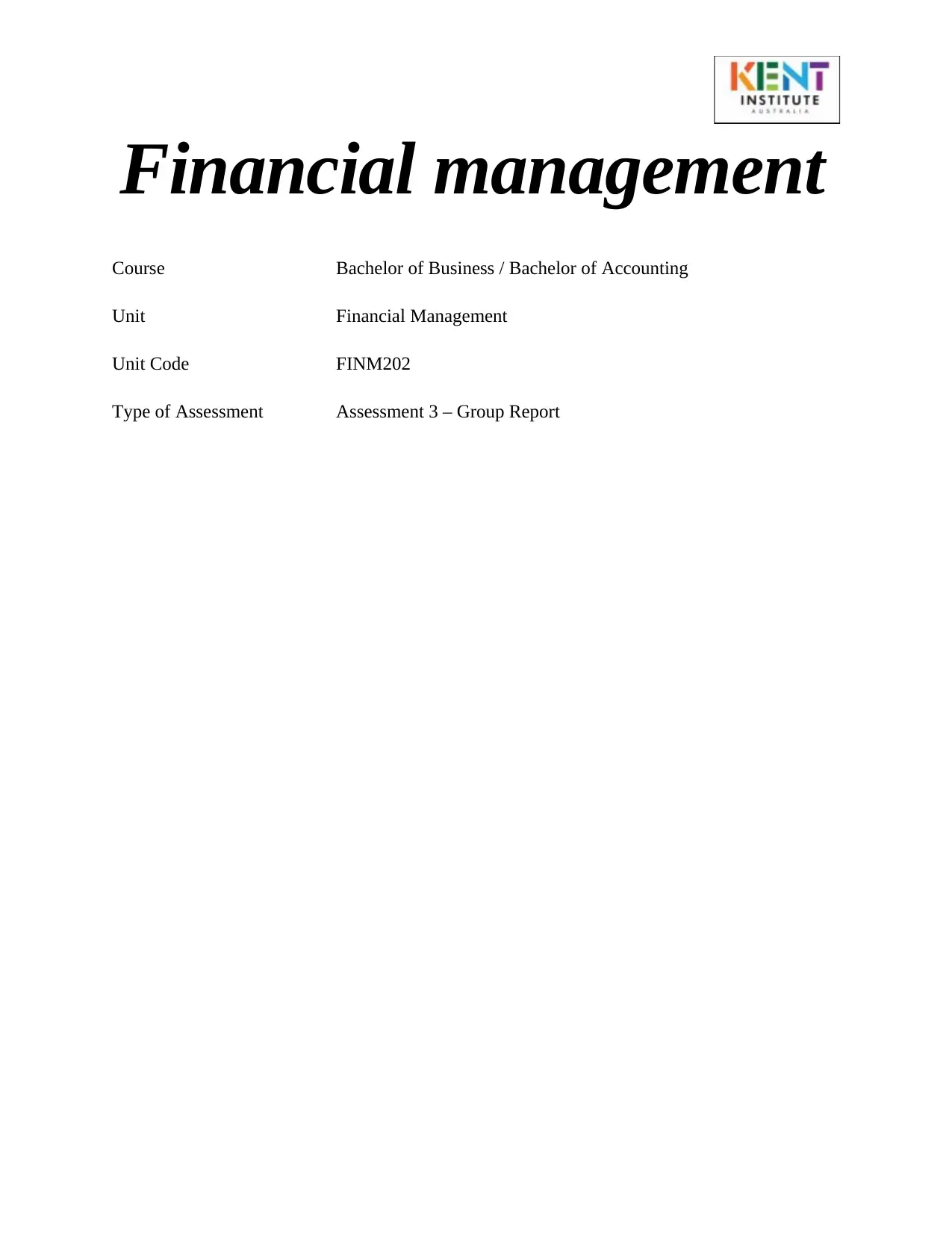
Financial management
Course Bachelor of Business / Bachelor of Accounting
Unit Financial Management
Unit Code FINM202
Type of Assessment Assessment 3 – Group Report
Course Bachelor of Business / Bachelor of Accounting
Unit Financial Management
Unit Code FINM202
Type of Assessment Assessment 3 – Group Report
Paraphrase This Document
Need a fresh take? Get an instant paraphrase of this document with our AI Paraphraser
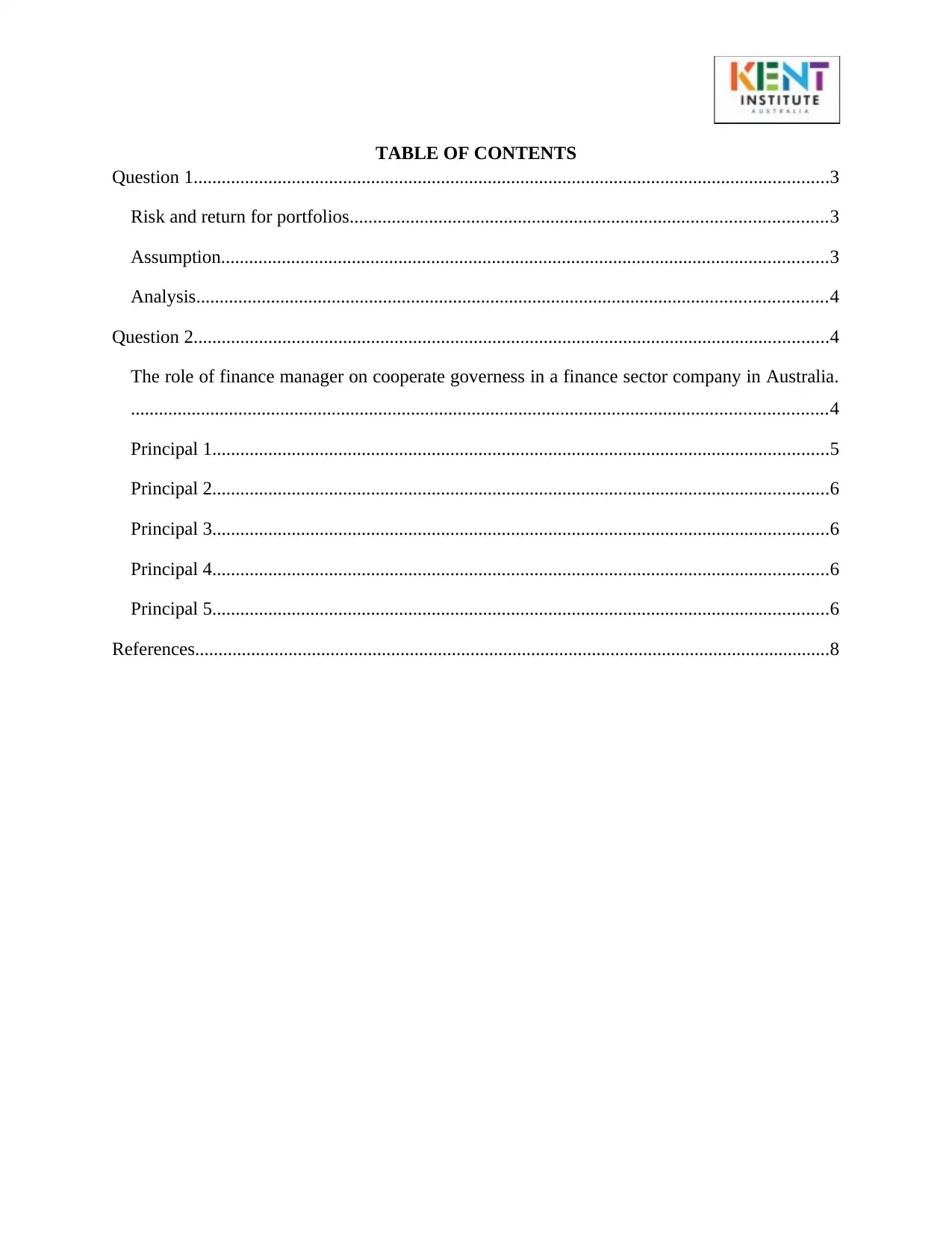
TABLE OF CONTENTS
Question 1........................................................................................................................................3
Risk and return for portfolios......................................................................................................3
Assumption..................................................................................................................................3
Analysis.......................................................................................................................................4
Question 2........................................................................................................................................4
The role of finance manager on cooperate governess in a finance sector company in Australia.
.....................................................................................................................................................4
Principal 1....................................................................................................................................5
Principal 2....................................................................................................................................6
Principal 3....................................................................................................................................6
Principal 4....................................................................................................................................6
Principal 5....................................................................................................................................6
References........................................................................................................................................8
Question 1........................................................................................................................................3
Risk and return for portfolios......................................................................................................3
Assumption..................................................................................................................................3
Analysis.......................................................................................................................................4
Question 2........................................................................................................................................4
The role of finance manager on cooperate governess in a finance sector company in Australia.
.....................................................................................................................................................4
Principal 1....................................................................................................................................5
Principal 2....................................................................................................................................6
Principal 3....................................................................................................................................6
Principal 4....................................................................................................................................6
Principal 5....................................................................................................................................6
References........................................................................................................................................8
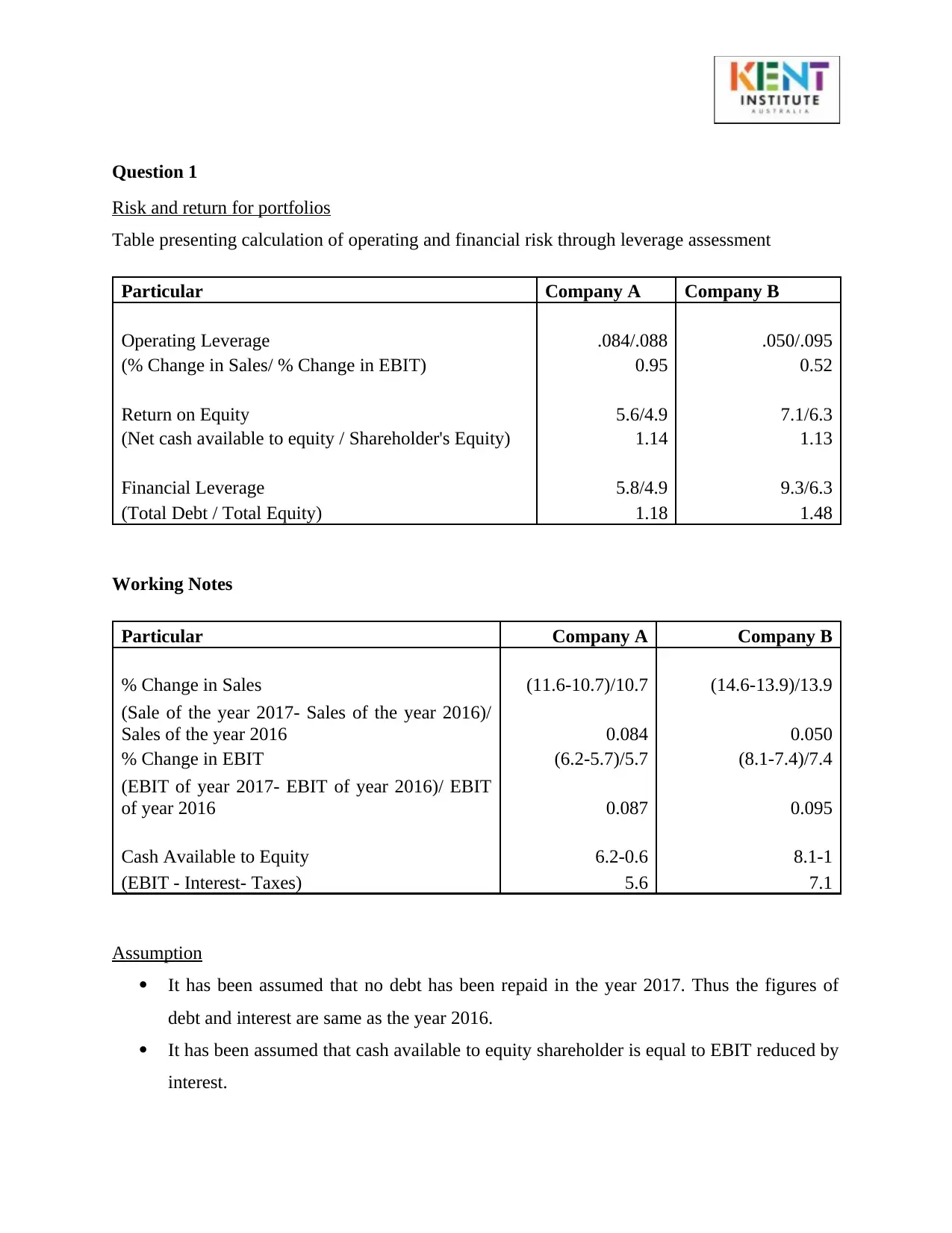
Question 1
Risk and return for portfolios
Table presenting calculation of operating and financial risk through leverage assessment
Particular Company A Company B
Operating Leverage .084/.088 .050/.095
(% Change in Sales/ % Change in EBIT) 0.95 0.52
Return on Equity 5.6/4.9 7.1/6.3
(Net cash available to equity / Shareholder's Equity) 1.14 1.13
Financial Leverage 5.8/4.9 9.3/6.3
(Total Debt / Total Equity) 1.18 1.48
Working Notes
Particular Company A Company B
% Change in Sales (11.6-10.7)/10.7 (14.6-13.9)/13.9
(Sale of the year 2017- Sales of the year 2016)/
Sales of the year 2016 0.084 0.050
% Change in EBIT (6.2-5.7)/5.7 (8.1-7.4)/7.4
(EBIT of year 2017- EBIT of year 2016)/ EBIT
of year 2016 0.087 0.095
Cash Available to Equity 6.2-0.6 8.1-1
(EBIT - Interest- Taxes) 5.6 7.1
Assumption
It has been assumed that no debt has been repaid in the year 2017. Thus the figures of
debt and interest are same as the year 2016.
It has been assumed that cash available to equity shareholder is equal to EBIT reduced by
interest.
Risk and return for portfolios
Table presenting calculation of operating and financial risk through leverage assessment
Particular Company A Company B
Operating Leverage .084/.088 .050/.095
(% Change in Sales/ % Change in EBIT) 0.95 0.52
Return on Equity 5.6/4.9 7.1/6.3
(Net cash available to equity / Shareholder's Equity) 1.14 1.13
Financial Leverage 5.8/4.9 9.3/6.3
(Total Debt / Total Equity) 1.18 1.48
Working Notes
Particular Company A Company B
% Change in Sales (11.6-10.7)/10.7 (14.6-13.9)/13.9
(Sale of the year 2017- Sales of the year 2016)/
Sales of the year 2016 0.084 0.050
% Change in EBIT (6.2-5.7)/5.7 (8.1-7.4)/7.4
(EBIT of year 2017- EBIT of year 2016)/ EBIT
of year 2016 0.087 0.095
Cash Available to Equity 6.2-0.6 8.1-1
(EBIT - Interest- Taxes) 5.6 7.1
Assumption
It has been assumed that no debt has been repaid in the year 2017. Thus the figures of
debt and interest are same as the year 2016.
It has been assumed that cash available to equity shareholder is equal to EBIT reduced by
interest.
⊘ This is a preview!⊘
Do you want full access?
Subscribe today to unlock all pages.

Trusted by 1+ million students worldwide
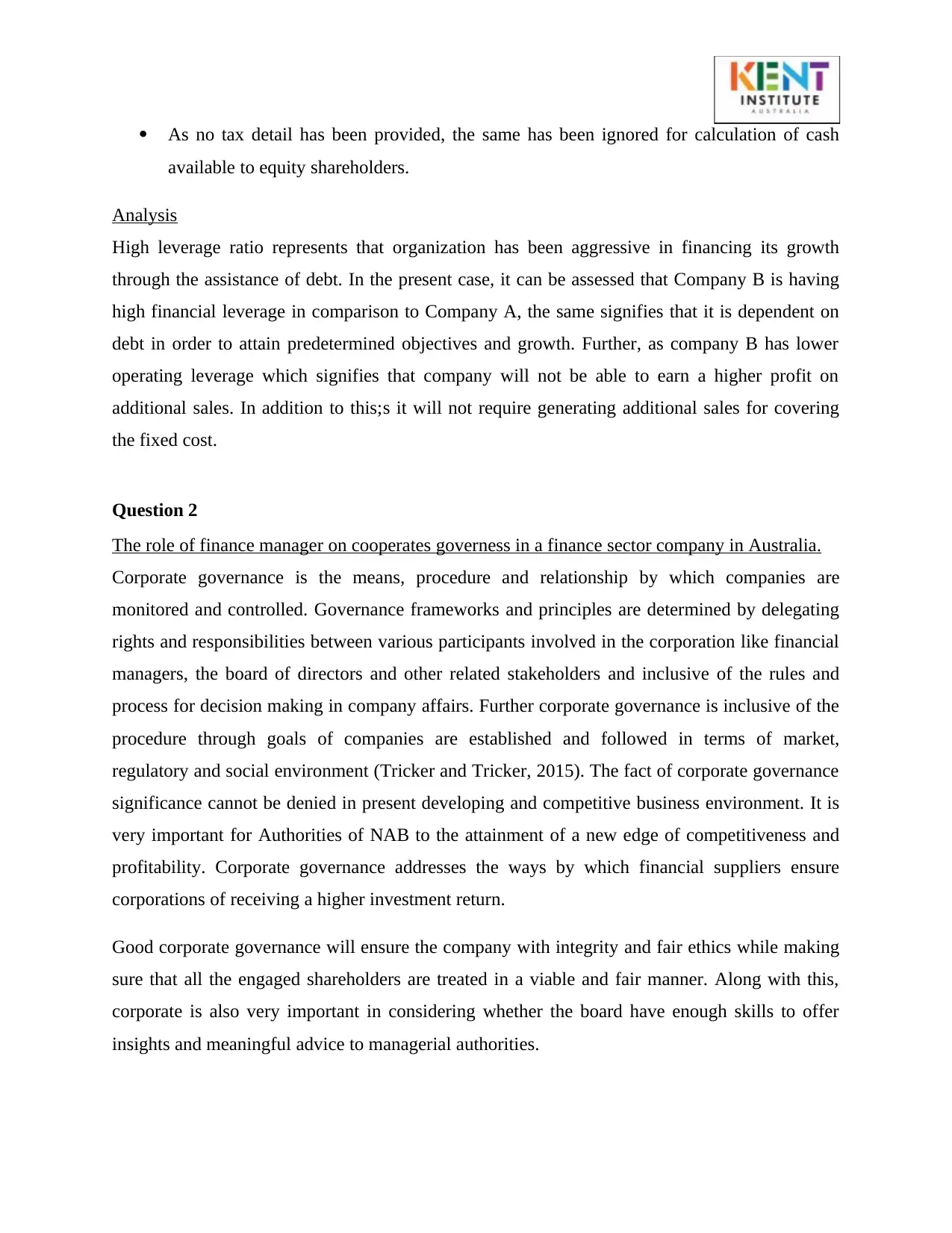
As no tax detail has been provided, the same has been ignored for calculation of cash
available to equity shareholders.
Analysis
High leverage ratio represents that organization has been aggressive in financing its growth
through the assistance of debt. In the present case, it can be assessed that Company B is having
high financial leverage in comparison to Company A, the same signifies that it is dependent on
debt in order to attain predetermined objectives and growth. Further, as company B has lower
operating leverage which signifies that company will not be able to earn a higher profit on
additional sales. In addition to this;s it will not require generating additional sales for covering
the fixed cost.
Question 2
The role of finance manager on cooperates governess in a finance sector company in Australia.
Corporate governance is the means, procedure and relationship by which companies are
monitored and controlled. Governance frameworks and principles are determined by delegating
rights and responsibilities between various participants involved in the corporation like financial
managers, the board of directors and other related stakeholders and inclusive of the rules and
process for decision making in company affairs. Further corporate governance is inclusive of the
procedure through goals of companies are established and followed in terms of market,
regulatory and social environment (Tricker and Tricker, 2015). The fact of corporate governance
significance cannot be denied in present developing and competitive business environment. It is
very important for Authorities of NAB to the attainment of a new edge of competitiveness and
profitability. Corporate governance addresses the ways by which financial suppliers ensure
corporations of receiving a higher investment return.
Good corporate governance will ensure the company with integrity and fair ethics while making
sure that all the engaged shareholders are treated in a viable and fair manner. Along with this,
corporate is also very important in considering whether the board have enough skills to offer
insights and meaningful advice to managerial authorities.
available to equity shareholders.
Analysis
High leverage ratio represents that organization has been aggressive in financing its growth
through the assistance of debt. In the present case, it can be assessed that Company B is having
high financial leverage in comparison to Company A, the same signifies that it is dependent on
debt in order to attain predetermined objectives and growth. Further, as company B has lower
operating leverage which signifies that company will not be able to earn a higher profit on
additional sales. In addition to this;s it will not require generating additional sales for covering
the fixed cost.
Question 2
The role of finance manager on cooperates governess in a finance sector company in Australia.
Corporate governance is the means, procedure and relationship by which companies are
monitored and controlled. Governance frameworks and principles are determined by delegating
rights and responsibilities between various participants involved in the corporation like financial
managers, the board of directors and other related stakeholders and inclusive of the rules and
process for decision making in company affairs. Further corporate governance is inclusive of the
procedure through goals of companies are established and followed in terms of market,
regulatory and social environment (Tricker and Tricker, 2015). The fact of corporate governance
significance cannot be denied in present developing and competitive business environment. It is
very important for Authorities of NAB to the attainment of a new edge of competitiveness and
profitability. Corporate governance addresses the ways by which financial suppliers ensure
corporations of receiving a higher investment return.
Good corporate governance will ensure the company with integrity and fair ethics while making
sure that all the engaged shareholders are treated in a viable and fair manner. Along with this,
corporate is also very important in considering whether the board have enough skills to offer
insights and meaningful advice to managerial authorities.
Paraphrase This Document
Need a fresh take? Get an instant paraphrase of this document with our AI Paraphraser
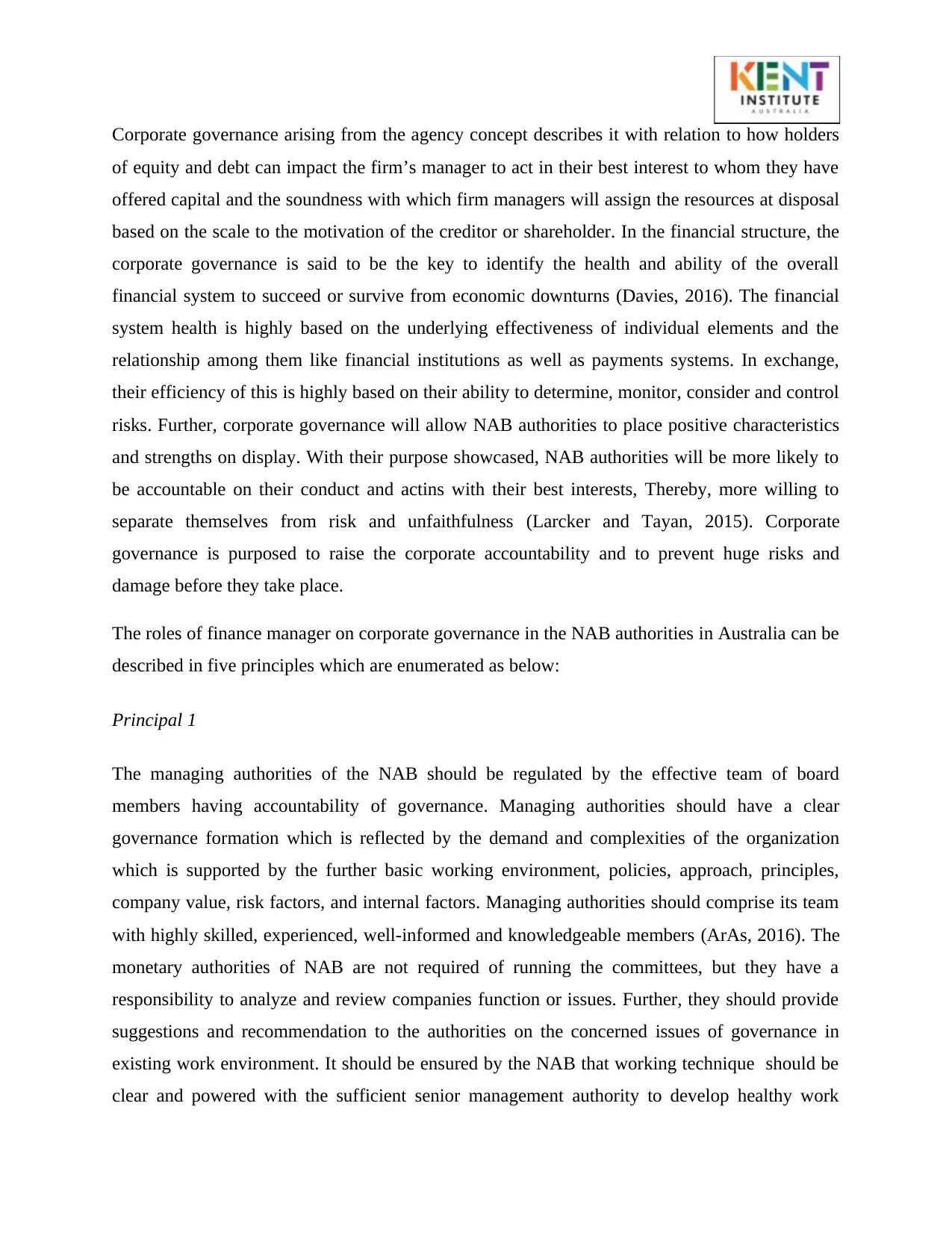
Corporate governance arising from the agency concept describes it with relation to how holders
of equity and debt can impact the firm’s manager to act in their best interest to whom they have
offered capital and the soundness with which firm managers will assign the resources at disposal
based on the scale to the motivation of the creditor or shareholder. In the financial structure, the
corporate governance is said to be the key to identify the health and ability of the overall
financial system to succeed or survive from economic downturns (Davies, 2016). The financial
system health is highly based on the underlying effectiveness of individual elements and the
relationship among them like financial institutions as well as payments systems. In exchange,
their efficiency of this is highly based on their ability to determine, monitor, consider and control
risks. Further, corporate governance will allow NAB authorities to place positive characteristics
and strengths on display. With their purpose showcased, NAB authorities will be more likely to
be accountable on their conduct and actins with their best interests, Thereby, more willing to
separate themselves from risk and unfaithfulness (Larcker and Tayan, 2015). Corporate
governance is purposed to raise the corporate accountability and to prevent huge risks and
damage before they take place.
The roles of finance manager on corporate governance in the NAB authorities in Australia can be
described in five principles which are enumerated as below:
Principal 1
The managing authorities of the NAB should be regulated by the effective team of board
members having accountability of governance. Managing authorities should have a clear
governance formation which is reflected by the demand and complexities of the organization
which is supported by the further basic working environment, policies, approach, principles,
company value, risk factors, and internal factors. Managing authorities should comprise its team
with highly skilled, experienced, well-informed and knowledgeable members (ArAs, 2016). The
monetary authorities of NAB are not required of running the committees, but they have a
responsibility to analyze and review companies function or issues. Further, they should provide
suggestions and recommendation to the authorities on the concerned issues of governance in
existing work environment. It should be ensured by the NAB that working technique should be
clear and powered with the sufficient senior management authority to develop healthy work
of equity and debt can impact the firm’s manager to act in their best interest to whom they have
offered capital and the soundness with which firm managers will assign the resources at disposal
based on the scale to the motivation of the creditor or shareholder. In the financial structure, the
corporate governance is said to be the key to identify the health and ability of the overall
financial system to succeed or survive from economic downturns (Davies, 2016). The financial
system health is highly based on the underlying effectiveness of individual elements and the
relationship among them like financial institutions as well as payments systems. In exchange,
their efficiency of this is highly based on their ability to determine, monitor, consider and control
risks. Further, corporate governance will allow NAB authorities to place positive characteristics
and strengths on display. With their purpose showcased, NAB authorities will be more likely to
be accountable on their conduct and actins with their best interests, Thereby, more willing to
separate themselves from risk and unfaithfulness (Larcker and Tayan, 2015). Corporate
governance is purposed to raise the corporate accountability and to prevent huge risks and
damage before they take place.
The roles of finance manager on corporate governance in the NAB authorities in Australia can be
described in five principles which are enumerated as below:
Principal 1
The managing authorities of the NAB should be regulated by the effective team of board
members having accountability of governance. Managing authorities should have a clear
governance formation which is reflected by the demand and complexities of the organization
which is supported by the further basic working environment, policies, approach, principles,
company value, risk factors, and internal factors. Managing authorities should comprise its team
with highly skilled, experienced, well-informed and knowledgeable members (ArAs, 2016). The
monetary authorities of NAB are not required of running the committees, but they have a
responsibility to analyze and review companies function or issues. Further, they should provide
suggestions and recommendation to the authorities on the concerned issues of governance in
existing work environment. It should be ensured by the NAB that working technique should be
clear and powered with the sufficient senior management authority to develop healthy work
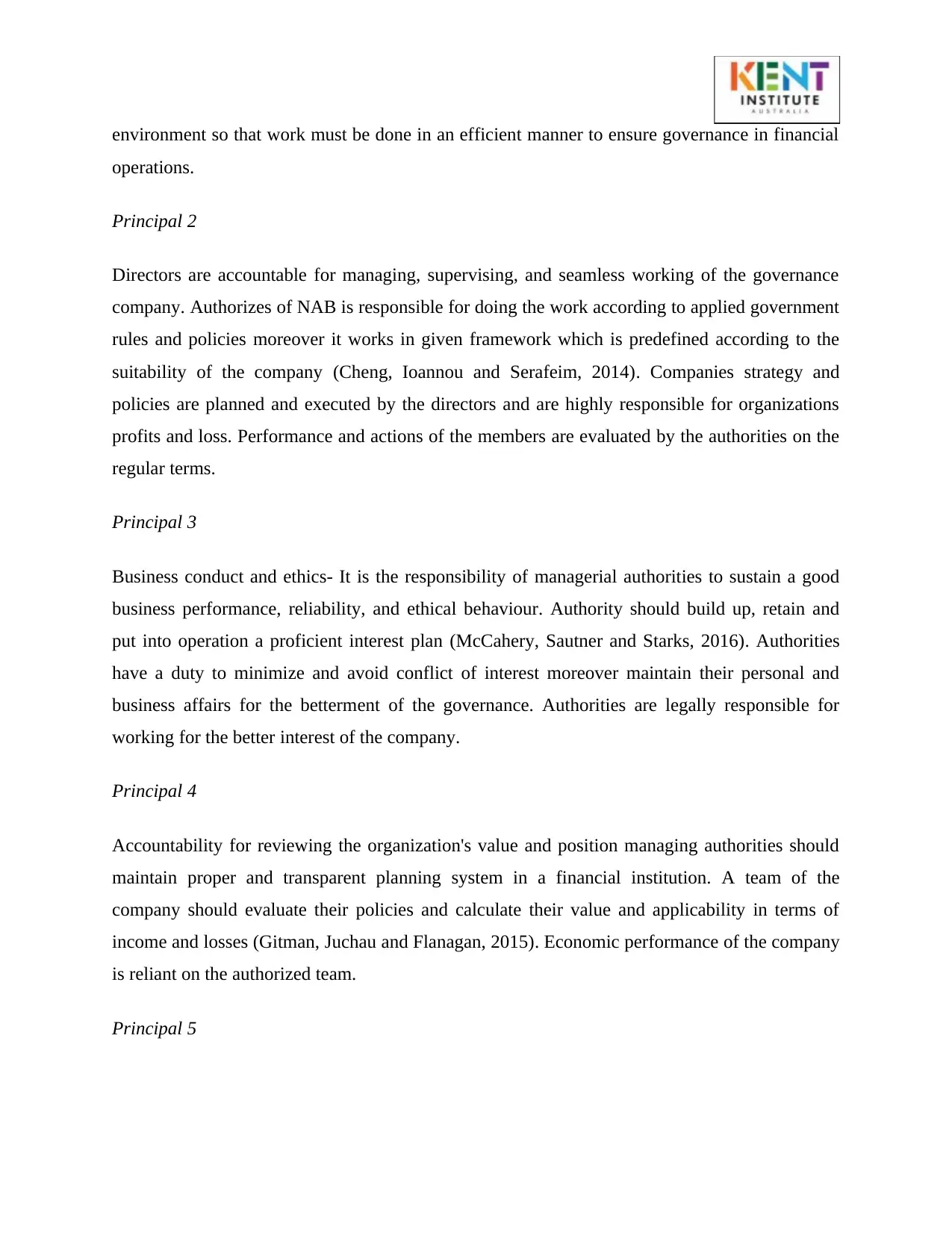
environment so that work must be done in an efficient manner to ensure governance in financial
operations.
Principal 2
Directors are accountable for managing, supervising, and seamless working of the governance
company. Authorizes of NAB is responsible for doing the work according to applied government
rules and policies moreover it works in given framework which is predefined according to the
suitability of the company (Cheng, Ioannou and Serafeim, 2014). Companies strategy and
policies are planned and executed by the directors and are highly responsible for organizations
profits and loss. Performance and actions of the members are evaluated by the authorities on the
regular terms.
Principal 3
Business conduct and ethics- It is the responsibility of managerial authorities to sustain a good
business performance, reliability, and ethical behaviour. Authority should build up, retain and
put into operation a proficient interest plan (McCahery, Sautner and Starks, 2016). Authorities
have a duty to minimize and avoid conflict of interest moreover maintain their personal and
business affairs for the betterment of the governance. Authorities are legally responsible for
working for the better interest of the company.
Principal 4
Accountability for reviewing the organization's value and position managing authorities should
maintain proper and transparent planning system in a financial institution. A team of the
company should evaluate their policies and calculate their value and applicability in terms of
income and losses (Gitman, Juchau and Flanagan, 2015). Economic performance of the company
is reliant on the authorized team.
Principal 5
operations.
Principal 2
Directors are accountable for managing, supervising, and seamless working of the governance
company. Authorizes of NAB is responsible for doing the work according to applied government
rules and policies moreover it works in given framework which is predefined according to the
suitability of the company (Cheng, Ioannou and Serafeim, 2014). Companies strategy and
policies are planned and executed by the directors and are highly responsible for organizations
profits and loss. Performance and actions of the members are evaluated by the authorities on the
regular terms.
Principal 3
Business conduct and ethics- It is the responsibility of managerial authorities to sustain a good
business performance, reliability, and ethical behaviour. Authority should build up, retain and
put into operation a proficient interest plan (McCahery, Sautner and Starks, 2016). Authorities
have a duty to minimize and avoid conflict of interest moreover maintain their personal and
business affairs for the betterment of the governance. Authorities are legally responsible for
working for the better interest of the company.
Principal 4
Accountability for reviewing the organization's value and position managing authorities should
maintain proper and transparent planning system in a financial institution. A team of the
company should evaluate their policies and calculate their value and applicability in terms of
income and losses (Gitman, Juchau and Flanagan, 2015). Economic performance of the company
is reliant on the authorized team.
Principal 5
⊘ This is a preview!⊘
Do you want full access?
Subscribe today to unlock all pages.

Trusted by 1+ million students worldwide
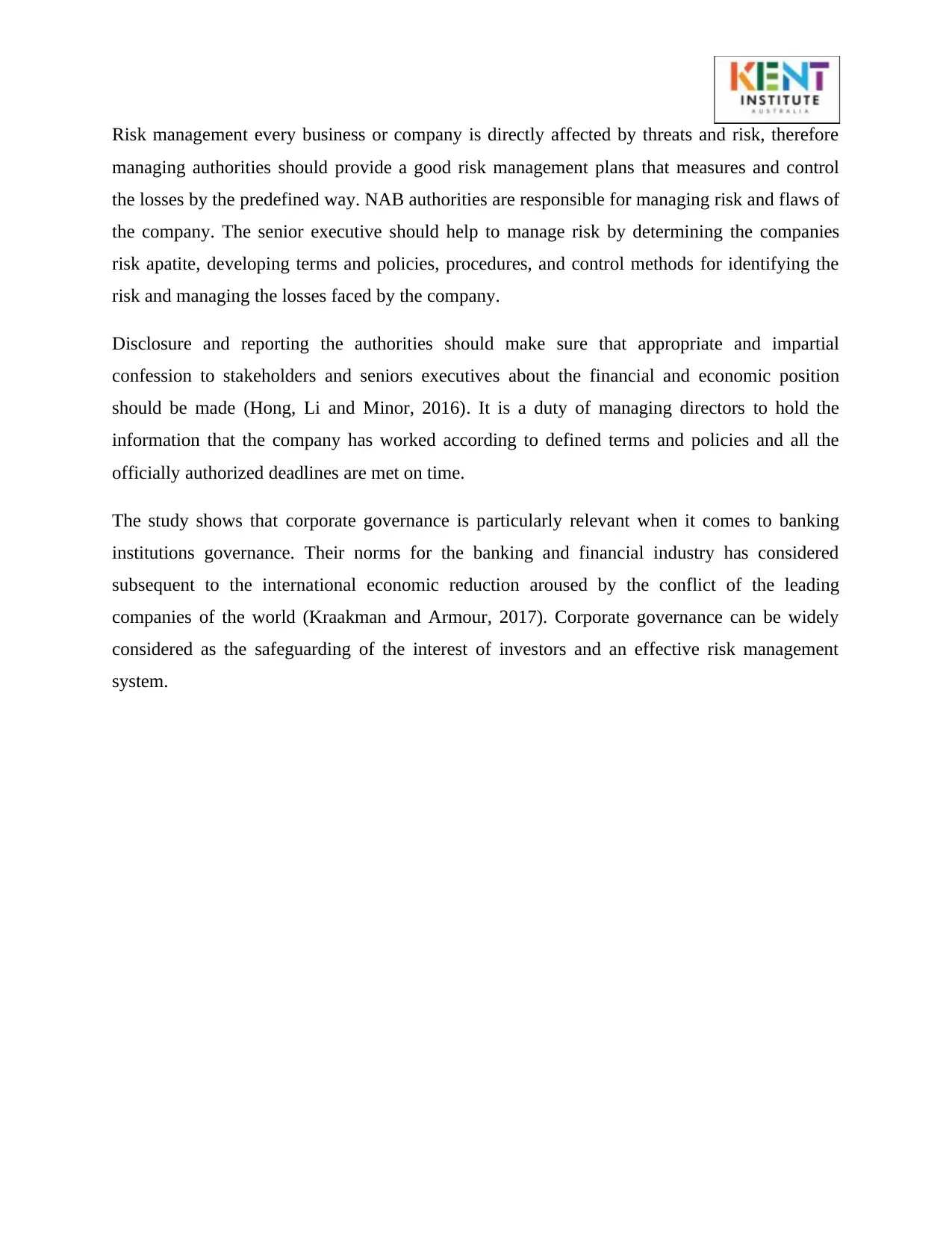
Risk management every business or company is directly affected by threats and risk, therefore
managing authorities should provide a good risk management plans that measures and control
the losses by the predefined way. NAB authorities are responsible for managing risk and flaws of
the company. The senior executive should help to manage risk by determining the companies
risk apatite, developing terms and policies, procedures, and control methods for identifying the
risk and managing the losses faced by the company.
Disclosure and reporting the authorities should make sure that appropriate and impartial
confession to stakeholders and seniors executives about the financial and economic position
should be made (Hong, Li and Minor, 2016). It is a duty of managing directors to hold the
information that the company has worked according to defined terms and policies and all the
officially authorized deadlines are met on time.
The study shows that corporate governance is particularly relevant when it comes to banking
institutions governance. Their norms for the banking and financial industry has considered
subsequent to the international economic reduction aroused by the conflict of the leading
companies of the world (Kraakman and Armour, 2017). Corporate governance can be widely
considered as the safeguarding of the interest of investors and an effective risk management
system.
managing authorities should provide a good risk management plans that measures and control
the losses by the predefined way. NAB authorities are responsible for managing risk and flaws of
the company. The senior executive should help to manage risk by determining the companies
risk apatite, developing terms and policies, procedures, and control methods for identifying the
risk and managing the losses faced by the company.
Disclosure and reporting the authorities should make sure that appropriate and impartial
confession to stakeholders and seniors executives about the financial and economic position
should be made (Hong, Li and Minor, 2016). It is a duty of managing directors to hold the
information that the company has worked according to defined terms and policies and all the
officially authorized deadlines are met on time.
The study shows that corporate governance is particularly relevant when it comes to banking
institutions governance. Their norms for the banking and financial industry has considered
subsequent to the international economic reduction aroused by the conflict of the leading
companies of the world (Kraakman and Armour, 2017). Corporate governance can be widely
considered as the safeguarding of the interest of investors and an effective risk management
system.
Paraphrase This Document
Need a fresh take? Get an instant paraphrase of this document with our AI Paraphraser
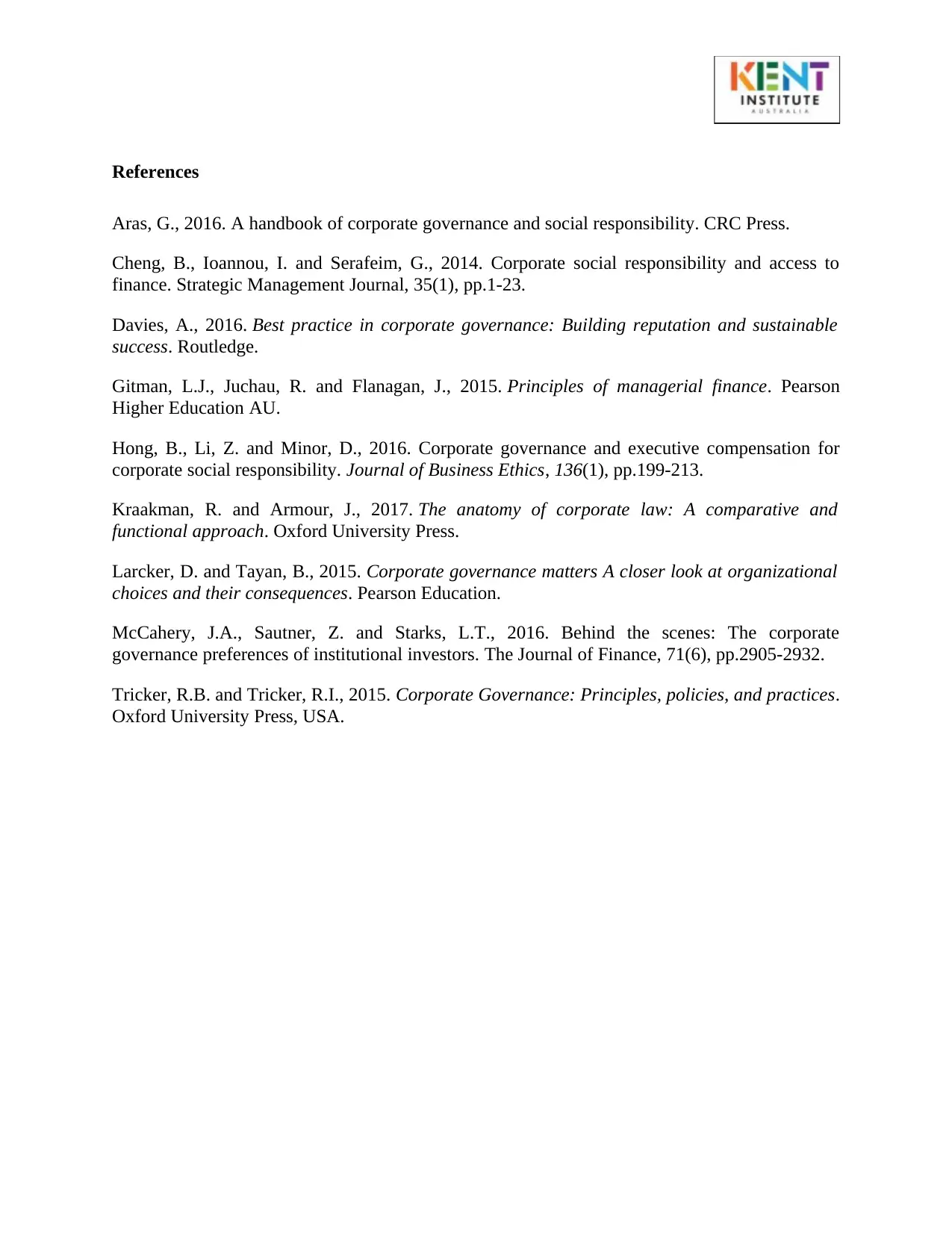
References
Aras, G., 2016. A handbook of corporate governance and social responsibility. CRC Press.
Cheng, B., Ioannou, I. and Serafeim, G., 2014. Corporate social responsibility and access to
finance. Strategic Management Journal, 35(1), pp.1-23.
Davies, A., 2016. Best practice in corporate governance: Building reputation and sustainable
success. Routledge.
Gitman, L.J., Juchau, R. and Flanagan, J., 2015. Principles of managerial finance. Pearson
Higher Education AU.
Hong, B., Li, Z. and Minor, D., 2016. Corporate governance and executive compensation for
corporate social responsibility. Journal of Business Ethics, 136(1), pp.199-213.
Kraakman, R. and Armour, J., 2017. The anatomy of corporate law: A comparative and
functional approach. Oxford University Press.
Larcker, D. and Tayan, B., 2015. Corporate governance matters A closer look at organizational
choices and their consequences. Pearson Education.
McCahery, J.A., Sautner, Z. and Starks, L.T., 2016. Behind the scenes: The corporate
governance preferences of institutional investors. The Journal of Finance, 71(6), pp.2905-2932.
Tricker, R.B. and Tricker, R.I., 2015. Corporate Governance: Principles, policies, and practices.
Oxford University Press, USA.
Aras, G., 2016. A handbook of corporate governance and social responsibility. CRC Press.
Cheng, B., Ioannou, I. and Serafeim, G., 2014. Corporate social responsibility and access to
finance. Strategic Management Journal, 35(1), pp.1-23.
Davies, A., 2016. Best practice in corporate governance: Building reputation and sustainable
success. Routledge.
Gitman, L.J., Juchau, R. and Flanagan, J., 2015. Principles of managerial finance. Pearson
Higher Education AU.
Hong, B., Li, Z. and Minor, D., 2016. Corporate governance and executive compensation for
corporate social responsibility. Journal of Business Ethics, 136(1), pp.199-213.
Kraakman, R. and Armour, J., 2017. The anatomy of corporate law: A comparative and
functional approach. Oxford University Press.
Larcker, D. and Tayan, B., 2015. Corporate governance matters A closer look at organizational
choices and their consequences. Pearson Education.
McCahery, J.A., Sautner, Z. and Starks, L.T., 2016. Behind the scenes: The corporate
governance preferences of institutional investors. The Journal of Finance, 71(6), pp.2905-2932.
Tricker, R.B. and Tricker, R.I., 2015. Corporate Governance: Principles, policies, and practices.
Oxford University Press, USA.
1 out of 8
Related Documents
Your All-in-One AI-Powered Toolkit for Academic Success.
+13062052269
info@desklib.com
Available 24*7 on WhatsApp / Email
![[object Object]](/_next/static/media/star-bottom.7253800d.svg)
Unlock your academic potential
Copyright © 2020–2025 A2Z Services. All Rights Reserved. Developed and managed by ZUCOL.



